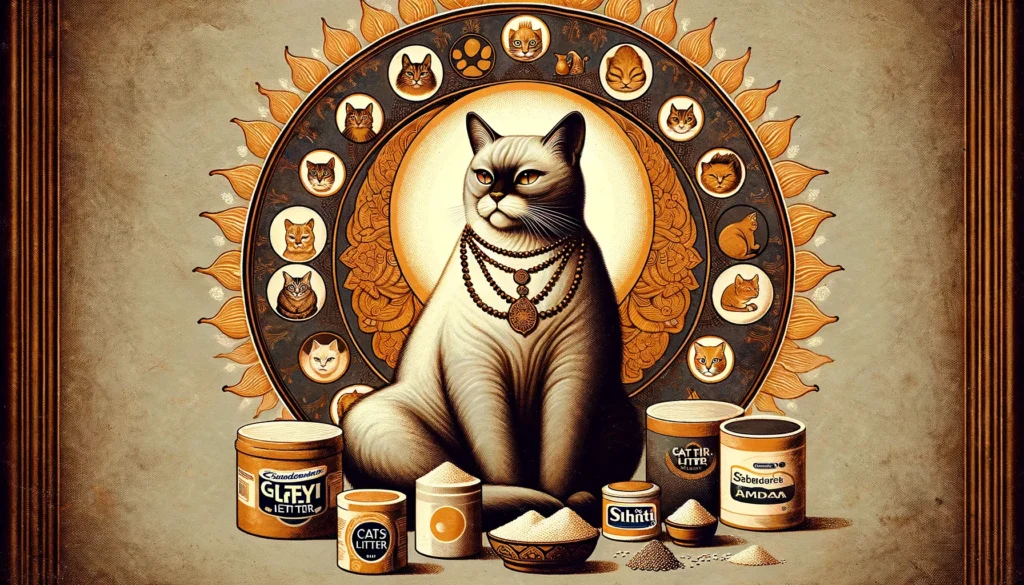So, can changing cat litter brand make cat sick? Yes, it absolutely can, and getting to the heart of this fur-raising issue while checking out how to dodge the sneezy, wheezy, and downright queasy outcomes is essential for your kitty’s well-being. This furry tale of caution isn’t just about swapping out one cat litter for another; it’s a deep dive into ensuring your feline’s health doesn’t hit a snag over something as seemingly simple as their bathroom sand.
- Introduce new litter slowly: Start by mixing a little of the new brand with the old to help your cat adjust without turning their nose up or worse.
- Keep an eye on your cat’s health: Watch for any signs of discomfort or allergies, because our furry friends can’t exactly tell us when something’s amiss.
- Choose litter wisely: Opt for dust-free or low-dust options to reduce respiratory irritants, and stay clear of heavily scented litters that might bother your kitty.
- Key Takeaways
- Key Risks Associated with Changing Cat Litters
- Health Concerns from Switching Cat Litter Brand
- Behavioral and Environmental Stress from Swapping Litter Types
- Risks of Specific Litter Materials: Natural vs. Synthetic Litters
- Critical Health Implications of Litter Choices: Clumping vs. Non-Clumping
- Cat Litter Switching FAQ
- Further Reading
- Conclusion
Key Takeaways
- Switching Litter Can Stress Cats: Changing your cat’s litter brand or type can lead to stress, confusion, and even health issues. It’s vital to introduce new litter gradually to allow your cat to adjust comfortably.
- Health Risks Exist: Some cats may experience allergic reactions or respiratory issues due to fragrances, dust, or chemical additives in different litters. Always monitor for adverse effects when switching litters.
- Preference Matters: Cats have personal preferences for litter types, whether clumping, non-clumping, scented, or unscented. Finding the right match is crucial for their litter box usage and overall satisfaction.
- Safety First: Selecting safe, non-toxic litter options is essential, especially for kittens prone to ingesting litter, to avoid intestinal blockages and other health concerns.
- Understanding Cat Behavior: Recognizing and respecting your cat’s litter box habits and preferences can enhance their well-being and prevent behavioral issues.
- Consultation is Key: Consult a veterinarian if you notice any health or behavioral changes after a litter switch, ensuring your cat remains healthy and happy.
Key Risks Associated with Changing Cat Litters
Exploring the risks involved in changing your cat’s litter brand is crucial for their health and wellbeing.
1. Allergic Reactions to New Brands Making Cats Sick
Cats can develop allergies to new materials or additives in litter, such as fragrances or dust, leading to various health issues.
- Allergic reactions may manifest as skin irritation or respiratory issues.
- Ingredients like perfumes and dust are common irritants.
- Monitor your cat closely for any signs of discomfort or allergic reactions after a litter change.
2. Dust and Respiratory Issues from Changed Cat Litter Brand
High-dust litters can trigger respiratory problems, especially in cats with pre-existing conditions.
- Dust particles can aggravate asthma or lead to respiratory distress.
- Even healthy cats can experience discomfort or respiratory issues.
- Opt for low-dust or dust-free litter options to minimize risk.
Health Concerns from Switching Cat Litter Brand
Changing cat litter brands can lead to several health concerns, including chemical sensitivities and intestinal blockages.
3. Chemical Sensitivities After Transitioning Litter Brands
Exposure to chemical additives in litter can cause nausea, vomiting, or diarrhea in cats.
- Chemical additives and fragrances in new litters can irritate sensitive cats.
- Symptoms like nausea, vomiting, or diarrhea signal sensitivity.
- Choose litters with natural ingredients to reduce the risk of chemical sensitivities.
4. Ingestion Risks from Non-Clumping vs. Clumping Litter
Non-clumping litters, if ingested, pose a risk of causing digestive tract blockages.
- Ingestion of non-clumping litter can lead to intestinal blockages.
- Cats cleaning their paws might ingest small amounts of litter.
- Clumping litter may be safer but still poses risks if ingested in large quantities.

Behavioral and Environmental Stress from Swapping Litter Types
Changes in litter can stress your cat, affecting their behavior and immune system.
5. Behavioral Stress Induced by Can Swapping Litter Types Harm Cats?
Environmental changes, including a new type of litter, can weaken a cat’s immune system.
- Sudden changes in litter can cause anxiety and stress in cats.
- Stress can lead to a weakened immune system, making cats more susceptible to illness.
- Maintaining consistency in the type of litter used can help minimize stress.
6. Changes in Litter Box Use: Natural vs. Synthetic Litters
A cat’s displeasure with new litter may lead to less frequent use of the litter box, potentially causing health issues.
- Cats may avoid the litter box if they dislike the texture or scent of new litter.
- Inconsistent litter box use can lead to urinary tract infections and other health problems.
- Consider gradually introducing new litter types to allow your cat to adjust.
Risks of Specific Litter Materials: Natural vs. Synthetic Litters
Certain materials used in cat litters carry specific risks, including toxicity and physical irritation.
7. Toxicity Concerns with Natural Litters
Some natural litters may be harmful if ingested, leading to sickness.
- Natural litters might contain materials that, if ingested, could cause intestinal blockages or toxic reactions.
- Ingredients like essential oils or plant-based products can be toxic to cats if consumed.
- Always monitor your cat’s reaction to new litter and consult a vet if ingestion occurs.
8. Paw Pad Irritations from Fragrance in Cat Litter
Litters made from rough materials can cause discomfort or infections in a cat’s paw pads.
- Fragranced litters, often found in both natural and synthetic varieties, can irritate cat’s paw pads.
- Rough textures can lead to scratches or cuts, which may become infected.
- Opting for finer, softer litters without added fragrances can help avoid these issues.
Critical Health Implications of Litter Choices: Clumping vs. Non-Clumping
Delving into less commonly discussed but equally important health implications of choosing certain cat litters.
9. Intestinal Obstructions from Ingesting Non-Clumping Litter
Certain litters can lead to blockages if ingested, especially risky for kittens or cats that eat litter.
- Non-clumping litters can clump inside the digestive tract, causing intestinal obstructions.
- Kittens and cats prone to eating litter are at a higher risk.
- Opt for safer litter options and monitor for ingestion behaviors.
10. Increased Stress and Lowered Immunity: A Result of Litter Allergy Symptoms
Stress from changing litter types can lower a cat’s immune response, making them more susceptible to illnesses.
- Allergic reactions to litter can cause stress, which weakens the immune system.
- Symptoms like itching, sneezing, or skin irritation indicate possible litter allergies.
- Consistently using a hypoallergenic litter can help reduce stress and bolster immunity.

Cat Litter Switching FAQ
What Happens When You Switch Your Cat’s Litter?
Changing your cat’s litter might confuse them at first. They need time to get used to the new texture and smell.
Do Cats Get Mad If You Change Their Litter?
Yes, some cats might get upset or stressed with a change in their litter because they’re creatures of habit. It’s all about giving them time to adjust to the new litter.
Is One Cat Litter Brand Better Than Another?
The brand of cat litter can matter because different brands offer different benefits, like odor control or less dust. However, the best brand depends on your cat’s personal preferences and health needs.
How Often Should You Switch Out Cat Litter?
You should completely replace the litter every two weeks, but scooping out waste daily is key to keeping it fresh. Also, washing the litter box during each change helps prevent bacteria buildup.
Clumping vs. Non-Clumping Litter, Which Wins?
Clumping litter is great for easy clean-up because it forms solid clumps when your cat uses it. However, non-clumping litter might be safer for kittens who tend to eat litter.
How Much Time Does It Take for a Cat to Adjust to New Litter?
Cats can take anywhere from a few days to a couple of weeks to get comfortable with new litter. Mixing a bit of the old litter with the new one can help ease the transition.
What’s the Best Type of Cat Litter to Use?
The best type of cat litter depends on your cat’s needs—some prefer fine-grained litter, while others might need a dust-free option due to allergies. It’s a good idea to try out a few to see what works best.
Which Cat Litter Is Safest for Your Feline Friend?
The safest cat litter is one that is dust-free, unscented, and made from natural materials to reduce the risk of allergies or ingestion. Look for litters with non-toxic components to keep your kitty healthy.
Further Reading
How to Change Brands of Litter
Conclusion
While the question, “can changing cat litter brand make cat sick?” looms large for many pet parents, navigating this landscape with care can significantly reduce risks. Prioritizing your furry friend’s health and comfort through informed choices makes all the difference.
- Gradual Introduction: Slowly mix new litter with the old to help your cat adjust.
- Monitor Reactions: Keep an eye out for any signs of discomfort or allergic reactions.
- Vet Consultation: When in doubt, a professional’s advice can guide the way.
In the grand scheme of things, ensuring your cat’s litter box happiness is a small but mighty way to show your love. Remember, a little observation and a lot of love go a long way. Can changing cat litter brand make a cat sick? Perhaps, but with the right approach, you can keep your whiskered companion both healthy and merry. So, what’s your next step to ensure your cat’s litter box is a sanctuary, not a stressor?


